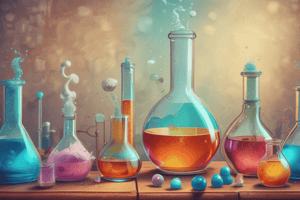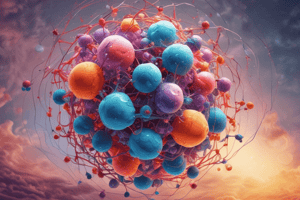Podcast
Questions and Answers
What was John Dalton's assertion regarding atoms of different elements?
What was John Dalton's assertion regarding atoms of different elements?
- They can change into each other during chemical reactions.
- They combine in simple whole-number ratios to form compounds. (correct)
- They are composed of larger indivisible particles.
- They are identical to atoms of other elements.
Who discovered the electron and in what year?
Who discovered the electron and in what year?
- John Dalton in 1844
- James Chadwick in 1932
- Eugen Goldstein in 1897
- J.J. Thomson in 1897 (correct)
What fundamental conclusion was drawn regarding electrons?
What fundamental conclusion was drawn regarding electrons?
- Each element has a different type of electron.
- Electrons must be balanced by negative particles. (correct)
- Atoms are entirely composed of electrons.
- Electrons can be changed into protons.
How did Robert Millikan contribute to the understanding of the electron?
How did Robert Millikan contribute to the understanding of the electron?
What particle did Eugen Goldstein observe in 1886, and what is its charge?
What particle did Eugen Goldstein observe in 1886, and what is its charge?
Which area of chemistry primarily focuses on substances without carbon?
Which area of chemistry primarily focuses on substances without carbon?
What is the main goal of applied chemistry?
What is the main goal of applied chemistry?
Which of the following is primarily concerned with the chemistry of living organisms?
Which of the following is primarily concerned with the chemistry of living organisms?
What differentiates compounds from the elements that make them up?
What differentiates compounds from the elements that make them up?
Which of the following best describes a homogeneous mixture?
Which of the following best describes a homogeneous mixture?
What major area of chemistry would involve studying the pollutants in the environment?
What major area of chemistry would involve studying the pollutants in the environment?
Who is credited with transforming chemistry into a science of measurement?
Who is credited with transforming chemistry into a science of measurement?
Which method can be used to separate a mixture based on particle size?
Which method can be used to separate a mixture based on particle size?
What historical practice contributed to the foundations of modern chemistry?
What historical practice contributed to the foundations of modern chemistry?
Which type of variable is manipulated during an experiment?
Which type of variable is manipulated during an experiment?
Which property is classified as an intensive property?
Which property is classified as an intensive property?
Which of the following best describes physical chemistry?
Which of the following best describes physical chemistry?
Which term describes chemistry used for practical purposes such as improving agriculture?
Which term describes chemistry used for practical purposes such as improving agriculture?
What is a characteristic of an endothermic change?
What is a characteristic of an endothermic change?
What does accuracy refer to in scientific measurements?
What does accuracy refer to in scientific measurements?
Which of the following statements about mixtures is NOT true?
Which of the following statements about mixtures is NOT true?
What distinguishes a scientific law from a theory?
What distinguishes a scientific law from a theory?
What process involves separating substances based on boiling points?
What process involves separating substances based on boiling points?
What is the primary difference between mass and weight?
What is the primary difference between mass and weight?
What is true about allotropes of an element?
What is true about allotropes of an element?
What is a qualitative observation?
What is a qualitative observation?
Which statement best describes estimation in scientific measurements?
Which statement best describes estimation in scientific measurements?
Temperature is a measure of which of the following?
Temperature is a measure of which of the following?
Which type of matter contains only one kind of atom?
Which type of matter contains only one kind of atom?
Flashcards are hidden until you start studying
Study Notes
Chemistry: The Study of Matter
- Chemistry is the study of the composition, structure, properties, and reactions of matter.
- Matter is anything that has mass and occupies space.
Six Major Areas of Chemistry
- Analytical Chemistry: Focuses on the composition of substances.
- Inorganic Chemistry: Primarily deals with substances that do not contain carbon.
- Organic Chemistry: Focuses on substances that contain carbon.
- Biochemistry: Studies the chemistry of living things.
- Physical Chemistry: Describes the behavior of chemicals, often using mathematics.
- Nuclear Chemistry: Deals with radioactivity, nuclear processes, and properties.
Pure vs. Applied Chemistry
- Pure Chemistry: Gathers knowledge for the sake of knowledge.
- Applied Chemistry: Utilizes chemistry to achieve specific goals in fields like medicine, agriculture, and manufacturing.
Chemistry in Everyday Life
- Chemists create materials for particular needs, such as Velcro (patented in 1955).
- Medicine and Biotechnology: Supply materials for healthcare, including vitamins, antibiotics, and materials for organ transplants.
- Energy: Chemistry plays a role in energy conservation and production, such as using soybeans to create biodiesel fuel.
- Agriculture: Chemistry is crucial for improving agricultural productivity, including soil management, pest control, and plant growth hormones.
- The Environment: Chemistry addresses the risks and benefits of scientific discoveries, including identifying and preventing pollutants.
- The Universe: Chemistry helps us study the composition of planets and analyze matter brought back to Earth.
The Origins of Chemistry
- The word "chemistry" comes from "alchemy," practiced in China and India since 400 B.C.
- Alchemy had two sides:
- Practical: Techniques for working with metals.
- Mystical: Concepts like perfection, where gold was considered the perfect metal.
- In the 1500s, a shift began from alchemy to science, supported by individuals like King Charles II and organizations like the Royal Society of London.
The Scientific Method
- A logical approach to solving problems or answering questions.
- Steps in the Scientific Method:
- Observations: Using senses to gather information.
- Quantitative: Involves numbers (e.g., 95°F).
- Qualitative: Involves word descriptions (e.g., hot).
- Formulating Hypotheses: Possible explanations or educated guesses.
- Performing Experiments: Gathering new information to determine the validity of a hypothesis.
- Observations: Using senses to gather information.
Variables in Experiments
- Manipulated Variable (Independent Variable): The factor that is changed.
- Responding Variable (Dependent Variable): The factor that is observed or measured.
Outcomes Over the Long Term
- Theory (Model): A well-tested set of hypotheses that offers an overall explanation of a phenomenon.
- Natural Law (or Scientific Law): Summarizes observations that apply to many different systems.
Distinguishing Laws and Theories
- Law: Summarizes what happened.
- Theory: Explains why it happened, and can change as new information is gathered.
CHAPTER II: Measurement and Estimation
- Estimation: Using knowledge of similar objects to determine the size or amount of a new object.
- Precision: How close measurements are to each other.
- Accuracy: How close a measurement is to the actual or accepted value.
- Measurement Systems:
- English (Standard) System: Used in the United States.
- Metric (SI) System: Used globally.
Basic Types of Measurement
- Length: Measures distance between objects.
- Mass: Measures the amount of matter in an object.
- Volume: Measures the amount of space an object occupies.
- Temperature: Measures the kinetic energy of atoms in an object.
CHAPTER III: Matter and Its Properties
- Matter: Anything that has mass and volume.
- Mass: The amount of matter in an object.
- Weight: The pull of gravity on an object
- Volume: The space an object occupies.
- Composition: What matter is made of.
- Properties: Describe the characteristics of matter, including appearance, smell, and behavior.
Atoms and Elements
- Atom: The basic building block of matter.
- Element: Contains only one type of atom.
- Monatomic Elements: Consist of unbonded, identical atoms.
- Polyatomic Elements: Consist of several identical atoms bonded together.
- Diatomic Elements: Examples include H2, O2, Br2, F2, I2, N2, and Cl2. Remember the mnemonic "HOBrFINCl = Hoberfinckle."
- Allotropes: Different forms of the same element in the same state of matter.
Compounds
- Contain two or more different types of atoms.
- Have properties that differ from their constituent elements.
Classifying Matter
- Substances: Have fixed composition and properties.
- Mixtures: Two or more substances mixed together, with varying composition and properties.
- Two Types of Mixtures:
- Homogeneous: (or solution) Particles are microscopic; uniform composition and properties throughout.
- Heterogeneous: Different composition and properties throughout the sample.
- Two Types of Mixtures:
Separating Mixtures
- Involves physical means or physical changes.
- Methods for Separating Mixtures:
- Sorting: By color, shape, texture, etc.
- Filtration: Based on particle size differences.
- Magnetism: One substance must contain iron.
- Chromatography: Exploits differences in solubility.
- Density: "Sink vs. float," utilizing a centrifuge if necessary.
- Distillation: Based on different boiling points.
- No chemical reactions are required to separate mixtures; substances are not bonded.
Properties of Matter
- Chemical Properties: Describe how a substance reacts with other substances.
- Physical Properties: Observable without altering the substance chemically.
- Extensive Properties: Depend on the quantity of substance present.
- Intensive Properties: Do not depend on the quantity of substance present.
Physical and Chemical Changes
- Physical Change: The formation of a mixture.
- Chemical Change: The formation of a compound.
Energy Changes
- Endothermic Change: The system absorbs heat.
- Exothermic Change: The system releases heat.
CHAPTER IV: Atomic Structure
- Democritus (460 B.C. -- 370 B.C.) - First to suggest the existence of atoms (from the Greek word "atomos"), believing they were indivisible and indestructible.
Dalton's Atomic Theory
- John Dalton (1766 -- 1844) Proposed a theory based on experimentation:
- Atoms of different elements combine in simple whole-number ratios to form chemical compounds.
- In chemical reactions, atoms are combined, separated, or rearranged, but never changed into atoms of another element.
- All elements are composed of tiny indivisible particles called atoms.
- Atoms of the same element are identical.
- Atoms of any one element are different from those of any other element.
Discovery of the Electron
- In 1897, J.J. Thomson: Used a cathode ray tube to deduce the presence of a negatively charged particle: the electron.
- Cathode Ray Tubes: Pass electricity through a gas at low pressure.
- 1916 -- Robert Millikan: Determined the mass of the electron as 1/1840 the mass of a hydrogen atom, with one unit of negative charge.
Conclusions from the Study of the Electron
- All elements contain identically charged electrons.
- Atoms are neutral, so they must contain positive particles to balance the negative charge of electrons.
- Electrons have so little mass that atoms must contain other particles that account for most of the mass.
Protons and Neutrons
- Eugen Goldstein in 1886: Observed the "proton" - a positively charged particle with a relative mass of 1 (or 1840 times that of an electron).
- 1932 -- James Chadwick: Confirmed the existence of the "neutron" - a neutral particle with a mass nearly equal to a proton.
Studying That Suits You
Use AI to generate personalized quizzes and flashcards to suit your learning preferences.




